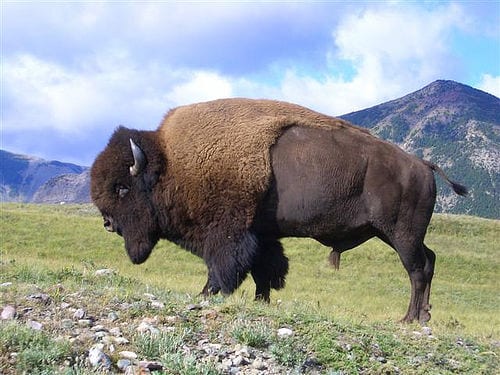Buffalo (June 23b)


Have you considered how the bison (buffalo) survive the heat of summer and the deep freeze of winters? And why aren’t there white bison? This color would seem to give a bison an evolutionary advantage. White would reflect the Sun’s summer heat which would keep the bison cooler. During the winter, the white would cause the bison to blend with the snow, making them less easily hunted by wolves. If people were designing a bison, we would probably pick white as the color of choice – like white sheep. Yet ,white bison are rare. As a matter of fact, white bison don’t do well in the wild – their numbers dwindle and disappear when mixed with regular bison.
Bison have dark coats because in the winter this color absorbs more heat from sunlight, helping to keep the animal warm. Bison are just like elk and deer; during the winter, they lose their appetite, producing less heat. Food is scarcer. With less food, bison need their dark coats to help maintain body warmth while burning minimal calories. Their hair also provides wonderful insulation – making it highly desirable for keeping both Native Americans and settlers warm on the most frigid of winter days. Every square inch of a bison’s skin is covered with ten times more hair than that of a cow. When an infrared device was used for a winter census, the elk and moose were clearly seen, but the bison hardly showed up. The bison appeared as crescents. These images were showing the bellies of the bison. The bison’s underbelly, not covered by hair, was at body temperature and showed up clearly on the infrared image.
Summers on the Great Plains can be extremely hot, so bison simply shed their winter coats. The constant winds on the prairies also aid in cooling the huge animals. But still the Sun is hot, and the dark coat absorbs heat. Unlike most mammals with sweat glands, bison don’t sweat but lose their heat through their breathing. Evaporating water in their lungs provides them with an efficient, alternative heat removal mechanism. The bison was designed to survive on the prairie with its extremes of hot and cold.
Isaiah 66:2
KJV: For all those things hath mine hand made, and all those things have been
NIV: Has not my hand made all these things, and so they came into being?
Reference
From the book “Have You Considered”?
Lott, Dale F. 2002. American Bison: A Natural History. University of California Press Ltd., p.53-56.
